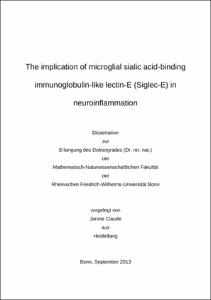Claude, Janine: The implication of microglial sialic acid-binding immunoglobulin-like lectin-E (Siglec-E) in neuroinflammation. - Bonn, 2014. - Dissertation, Rheinische Friedrich-Wilhelms-Universität Bonn.
Online-Ausgabe in bonndoc: https://nbn-resolving.org/urn:nbn:de:hbz:5n-35230
Online-Ausgabe in bonndoc: https://nbn-resolving.org/urn:nbn:de:hbz:5n-35230
@phdthesis{handle:20.500.11811/6044,
urn: https://nbn-resolving.org/urn:nbn:de:hbz:5n-35230,
author = {{Janine Claude}},
title = {The implication of microglial sialic acid-binding immunoglobulin-like lectin-E (Siglec-E) in neuroinflammation},
school = {Rheinische Friedrich-Wilhelms-Universität Bonn},
year = 2014,
month = mar,
note = {Microglia are the resident immune cells of the central nervous system (CNS). They display a whole set of recognition receptors on their cell surface to sense intact or lesioned cells in the CNS. A subfamily of these receptors are sialic acid-binding immunoglobulin like lectins (Siglecs). Siglecs can either exert activatory or inhibitory signals. Siglec-E is a member of this receptor family and has an immunoreceptor tyrosine based inhibitory motif (ITIM) in the cytoplasmic tail to suppress activatory microglial signals.
To study Siglec-E transcription and expression profile ex vivo, primary and stem cell-derived microglia were used. Via RT-PCR and flow cytometry it was shown that Siglec-E is expressed on microglia and was up-regulated following IFN-γ treatment. To study the functional role of Siglec-E, lentiviral knock-down and overexpression of Siglec-E was performed. Lentiviral overexpression of Siglec-E decreased whereas knock-down increased the phagocytosis rate of neural debris and its associated reactive oxygen burst. The extracellular domain of Siglec-E linked to the Fc-part of immunoglobulin bound to the sialic acid residues of the neuronal glycocalyx. Therefore, primary hippocampal neurons were co-cultured with the modified microglia. Overexpression and knock-down of Siglec-E led to an increase and decrease in relative neurite length, respectively. The neuroprotective effect of Siglec E was abrogated after removal of the sialic acid residues on the neuronal glycocalyx. Treatment with the anti-oxidant Trolox abolished the neurotoxic effect of the Siglec-E knock-down on neurite length.
In summary, our data suggest an immunomodulatory function of Siglec-E on microglia, which leads to a neuroprotective phenotype by decreasing the production of reactive oxygen species and a reduced phagocytosis rate of neural debris.},
url = {https://hdl.handle.net/20.500.11811/6044}
}
urn: https://nbn-resolving.org/urn:nbn:de:hbz:5n-35230,
author = {{Janine Claude}},
title = {The implication of microglial sialic acid-binding immunoglobulin-like lectin-E (Siglec-E) in neuroinflammation},
school = {Rheinische Friedrich-Wilhelms-Universität Bonn},
year = 2014,
month = mar,
note = {Microglia are the resident immune cells of the central nervous system (CNS). They display a whole set of recognition receptors on their cell surface to sense intact or lesioned cells in the CNS. A subfamily of these receptors are sialic acid-binding immunoglobulin like lectins (Siglecs). Siglecs can either exert activatory or inhibitory signals. Siglec-E is a member of this receptor family and has an immunoreceptor tyrosine based inhibitory motif (ITIM) in the cytoplasmic tail to suppress activatory microglial signals.
To study Siglec-E transcription and expression profile ex vivo, primary and stem cell-derived microglia were used. Via RT-PCR and flow cytometry it was shown that Siglec-E is expressed on microglia and was up-regulated following IFN-γ treatment. To study the functional role of Siglec-E, lentiviral knock-down and overexpression of Siglec-E was performed. Lentiviral overexpression of Siglec-E decreased whereas knock-down increased the phagocytosis rate of neural debris and its associated reactive oxygen burst. The extracellular domain of Siglec-E linked to the Fc-part of immunoglobulin bound to the sialic acid residues of the neuronal glycocalyx. Therefore, primary hippocampal neurons were co-cultured with the modified microglia. Overexpression and knock-down of Siglec-E led to an increase and decrease in relative neurite length, respectively. The neuroprotective effect of Siglec E was abrogated after removal of the sialic acid residues on the neuronal glycocalyx. Treatment with the anti-oxidant Trolox abolished the neurotoxic effect of the Siglec-E knock-down on neurite length.
In summary, our data suggest an immunomodulatory function of Siglec-E on microglia, which leads to a neuroprotective phenotype by decreasing the production of reactive oxygen species and a reduced phagocytosis rate of neural debris.},
url = {https://hdl.handle.net/20.500.11811/6044}
}






